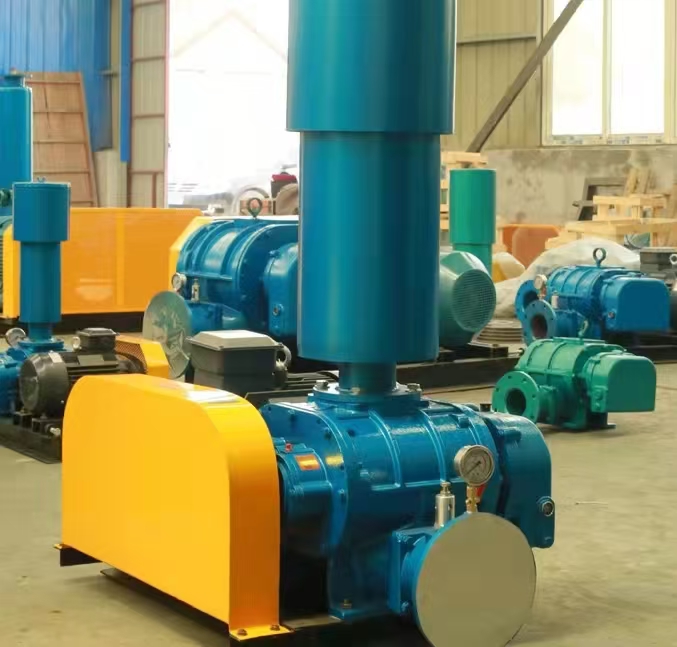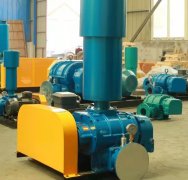Dense Roots blower (also known as compact Roots blower) is a type of positive displacement blower with a compact structure, widely used in fields such as sewage treatment, pneumatic conveying, aquaculture, and chemical engineering. Its core advantages are mainly reflected in the following aspects:
---

**1. Energy saving**
-Volumetric design: Gas transportation is achieved through synchronous reverse rotation of two three or two bladed rotors, with minimal leakage and high efficiency, especially in constant flow demand scenarios, which is more energy-efficient than centrifugal fans.
-Low internal compression loss: Roots blower can directly transport gas without internal compression, suitable for low-pressure (usually ≤ 0.1MPa) continuous gas supply scenarios, with low energy consumption.
---
**2. Compact structure, space saving**
-* * Dense design * *: Optimized internal structure and shell, with small volume and light weight, suitable for installation environments with limited space (such as small sewage treatment plants or workshops).
-Modular integration: Some models are equipped with silencers, filters, or variable frequency control systems to reduce the space occupied by external accessories.
---
**3. Stable and reliable, easy to maintain**
-Non contact rotor design: There is a small gap between the rotors, no mechanical friction, and a long service life (usually more than 10 years).
-* * Simple mechanical structure * *: The main components are only the rotor, synchronous gear, and housing, with a low failure rate. Maintenance only requires regular replacement of lubricating oil, filters, and belts (if any).
---
**4. Constant flow, resistant to load changes**
-Hard wind characteristics: The output flow rate is almost unaffected by pressure changes (pressure is determined by the resistance of the backend system), making it suitable for processes that require stable flow rates (such as oxygen supply in aeration tanks).
-No need for pressure relief valve: Within the allowable working pressure range, even if the outlet is blocked, the fan will not be damaged (with valve protection for overpressure).
---
**5. Strong adaptability**
-* * Medium compatibility * *: It can transport air, biogas, neutral gases, etc., and special materials (such as stainless steel) can also handle corrosive gases.
-Environmental tolerance: Some models have explosion-proof, waterproof, or high-temperature resistant designs, suitable for harsh environments such as chemical and mining.
---
**6. Low noise and vibration**
-Optimize rotor profile: The three blade rotor design has lower noise than the traditional two blade design (which can be reduced to below 75dB).
-* * Built in noise reduction measures * *: Dense models are often equipped with silencers or soundproof covers to reduce noise pollution.
---
**7. Cost advantage**
-Low initial investment: Compared to screw fans or centrifugal fans, Roots fans of the same specifications are priced lower.
-Low maintenance cost: Standardized spare parts (such as gears and bearings) for easy replacement.
---
**Examples of applicable scenarios**
-* * Sewage treatment * *: Aeration tank for oxygen supply, stable flow rate, and resistance to humid environments.
-Pneumatic conveying: Pipeline transportation of granular materials such as flour and cement.
-Aquaculture: aerating to ensure oxygen content in the water.
-Vacuum packaging: Quickly suction gas to create a vacuum environment.
---
**Precautions**
-Pressure limit: Not suitable for high-pressure scenarios (generally<0.1MPa), otherwise efficiency will drop sharply.
-Temperature rise issue: Long term operation requires monitoring of exhaust temperature, and heat dissipation needs to be strengthened in high-temperature environments.
-* * Noise sensitive scenarios * *: Despite the noise reduction design, it is still necessary to evaluate whether additional sound insulation measures are needed.
---
In summary, dense Roots blowers have significant advantages in low-pressure gas transportation due to their compactness, stability, and economy, especially suitable for small and medium-sized projects that require constant flow and limited space. When selecting, it is necessary to match parameters with specific working conditions (pressure, flow rate, medium).



